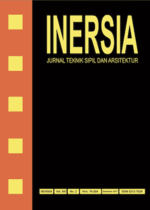KARAKTERISTIK BETON DENGAN AGREGAT KASAR PELLET POLYPROPYLENE DAN VARIASI AGREGAT HALUS
DOI:
https://doi.org/10.21831/inersia.v10i1.4427Abstract
This research aimed to determine weight-volume, compressive strength, and split tensile strength of concrete due to the use of plastic pellets (polypropylene) as a coarse aggregate and stone ash as a partial/a whole replacement sand needs to utilize plastic waste and stone ash which is a waste of stone-crushing machine. The test specimen was made of a mixture of cement, sand, coarse aggregate of plastic pellets and water. The design of concrete mix by Indonesian National Standard (SNI) with normal concrete compressive strength of 10 MPa was planned. Variations of the specimen lied on the mixture of stone ash and sand, respectively for 0% and 100%, 25% and 75%, 50% and 50%, 75% and 25%, and 100% and 0%. The object of the research was a cylinder diameter of 100 mm and height of 200 mm for testing of weight-volume and compressive strength, and a cylinder diameter of 150 mm and height of 300 mm for testing of split tensile strength. The results of the research showed that the higher level volume of stone ash in concrete, the higher weight-volume and compressive strength. It was increased in split tensile strength of the concrete levels of 0% to 50% stone ash, and it was decreased in levels of 75% and 100% stone ash. The results of weight-volume testing showed that all variations of concrete were classified as lightweight concrete because it had weight-volume of less than 1850 kg/m3 (Balitbang Kimpraswil, 2003b). Neville and Brooks (1987) also classified the concrete as lightweight concrete because it had weight-volume evenly less than 1800 kg/m3 and 1900 kg/m3. The results of compressive strength testing showed that concrete with stone ash content 0-75% were classified as very lightweight structure because it had compressive strength of less than 6.89 MPa, while levels of 100% were categorized as very lightweight structure with compressive strength from 6.89 to 17.24 MPa (Balitbang Kimpraswil, 2003b). According to Neville and Brooks (1987), concrete with stone ash content 0-75% were classified as lightweight concrete for heat resistant (compressive strength of 0.7 to 7 MPa), while levels of 100% were categorized as lightweight concrete for masonry (compressive strength of 7-14 MPa).Keywords: Polypropylene (PP), stone ash, compressive strength, split tensile strength, lightweight concreteDownloads
How to Cite
Hasmar Halim, N. A. J. (2015). KARAKTERISTIK BETON DENGAN AGREGAT KASAR PELLET POLYPROPYLENE DAN VARIASI AGREGAT HALUS. INERSIA Lnformasi Dan Ekspose Hasil Riset Teknik Sipil Dan Arsitektur, 10(1). https://doi.org/10.21831/inersia.v10i1.4427
Issue
Section
Articles
License
Authors who publish with INERSIA journal agree to the following terms:
- Authors retain copyright and grant the INERSIA journal right of first publication with the work simultaneously licensed under Creative Commons Attribution License (CC BY 4.0) that allows others to share the work with an acknowledgment of the work's authorship and initial publication in this journal.
- Authors can enter into separate, additional contractual arrangements for the non-exclusive distribution of the published version of the work (e.g., post it to an institutional repository or edit it in a book), with an acknowledgment of its initial publication in this journal.
- Authors are permitted and encouraged to post their work online (e.g., in institutional repositories or on their website) before and during the submission process, as it can lead to productive exchanges, as well as earlier and greater citation of published work.

INERSIA by https://journal.uny.ac.id/index.php/inersia was distributed under a Creative Commons Attribution 4.0 International License










